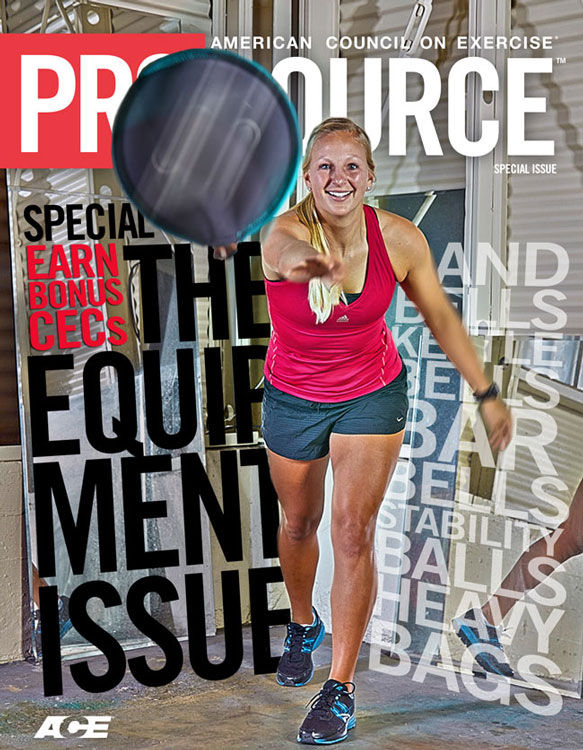
Fitness professionals who want to provide the most effective workouts for their clients should always be on the lookout out for new exercise equipment especially if it is affordable, portable and provides a wide variety of exercise options. SandBells by Hyperwear have only been on the market for a few years yet are quickly becoming a “must-have” for a trainer’s tool box.
The ACE Integrated Fitness Training® Model (ACE IFT® Model) establishes a scientifically based method of progressing intensity for Functional Movement and Resistance Training from less-intense Stability and Mobility exercises to improve posture in Phase 1 to high-intensity power exercises to burn calories and enhance athletic Performance in Phase 4. Finding exercise equipment that can provide an effective challenge for clients of all skill levels can be tough but SandBells are one of the few pieces of portable equipment that can easily be used by all types of clients to improve muscular endurance, strength and explosive power.
How to Choose the Correct Sandbell for Your Needs
Sandbells come in a variety of weights and sizes. Some come pre-filled with sand, while others come as kits that allow you to add as much (or as little) sand as you need. Lighter weights are 3, 6 and 10 pounds; moderate-sized weights are 12 and 15 pounds; and heavier weights are 20 pounds and up.
Unlike dumbbells or kettlebells, there are no handles on Sandbells and, unlike a medicine ball, they do not stay in the same shape and are constantly moving. Due to their shifting mass and inherent instability, Sandbells require a strong grip. Therefore, it’s a good idea to start with a slightly lighter weight then what you might use with dumbbells or medicine balls. The sand will shift and move depending on the speed of movement, so start with slow, controlled movements to get used to the feel before increasing the tempo of an exercise.
SandBells are unique in that they are, as the name suggests, filled with sand creating an unstable, shifting mass. The constantly changing mass combined with the fact that they can be easily (and safely) thrown makes SandBells an effective training tool to meet the needs of exercise programming for all four levels of ACE IFT Model. Traditional free weight equipment like dumbbells, medicine balls or even kettlebells provide external resistance in the form of a solid, stable mass. One important feature of the SandBell is that it can be grabbed in a variety of different ways which can improve grip strength which is related to upper arm and shoulder strength. Developing a strong grip can improve strength and stability of the shoulder at the gleno-humeral joint and is an often overlooked component of a well-rounded workout program.
Exercises for the Stability and Mobility phase of the ACE IFT are designed to improve the stability of the knee, lumbar spine and scapula-thoracic joints while enhancing mobility of the mobile ankle, hip and gleno-humeral joints along with the thoracic spine. SandBells can be used to improve core stability while enhancing range-of-motion in the mobile joints. Exercises in the Movement phase of the ACE IFT should combine stability and mobility to improve movement efficiency. SandBells can be easily moved in all directions to effectively load the foundational patterns of movement: squatting, lunging, pushing, pulling and rotating. The Load training phase is designed to improve muscle force production and heavier SandBells can be used to improve muscle force output. Finally Performance training adds a velocity component where performance enhancement for endurance activities requires sustaining a minimal force over an extended period of time and enhancing performance for power-based activities requires generating a high amount of force in the shortest time possible. SandBells can be used for either high-repetition exercises to develop muscular endurance or be thrown to develop explosive power.
Because of their unique design and versatility SandBells can easily be used in a variety of reactive games to challenge clients or fitness class participants with exercises requiring cognitive thought processing. An example of a reactive exercise is to have three different colored SandBells (each weight is identified by a distinct color) and calling out a color for a client to move towards and either touch and return to the starting position or lift and return to the starting position. This drill can be done for repetitions and time and creates a unique stimulus which is both fun and engaging for clients.
If you are looking for new equipment that is versatile, easy to transport and extremely fun to use then consider adding some SandBells to your training toolbox. You will have a wide variety of programming options and your clients will quickly develop a love-hate relationship with these “bags of sand” (as one of my clients calls them).
THE WORKOUT
Foundation (ACE IFT Model Phases 1 and 2):
The purpose of this workout is to user a light-to-moderate weight SandBell to integrate stability and mobility in the foundational movement patterns. For each exercise the client should be able to maintain a neutral lumbar spine, an extended thoracic spine and forward bending movements should come from the hips, not the lumbar spine. The Jumping jacks and Overhead slams are added to provide an aerobic challenge.
Do each exercise for 10-to-12 repetitions and 2-to-3 sets resting 30 seconds between sets. To increase the cardiorespiratory challenge do the exercises in a circuit format moving from one to the next with only 15 seconds rest between each exercise, rest for 2 minutes at the end of the circuit before repeating.
Experienced (ACE IFT Model phases 2 and 3):
The purpose of this workout is to use a moderate-to-heavy weight SandBell in order to enhance muscle force production in the foundational movement patterns. The client should be able to control his or her center of gravity over a constantly moving base of support.
Perform each exercise for six to 10 repetitions and complete three to four sets, with a 30-second rest period between sets. To increase the cardiorespiratory challenge, do the exercises in a circuit format, moving from one to the next with only 15 seconds rest between each exercise. Rest for two minutes at the end of each round before starting the next one.
Expert (ACE IFT Model Phases 3 and 4):
The purpose of this workout is to use a moderate-to-heavy weight SandBell to improve explosive strength and enhance the velocity of force production. The high-intensity nature of this workout makes it an excellent option for maximizing caloric expenditure.
Perform each exercise for six to 10 repetitions and complete three to five sets, resting 15 to 30 seconds between each exercise. For the explosive exercises, however, rest 30 to 45 seconds before starting the next one. To increase the cardiorespiratory challenge, perform the exercises in a circuit format, moving from one to the next with only 15 seconds of rest between each exercise. Rest for two minutes at the end of each round before starting the next one.





 by
by 


